 Heavybell
6h ago
•
100%
Heavybell
6h ago
•
100%
Knowing he won't be around to see the result of his climate change denial does not make me happier :/
 Heavybell
12h ago
•
100%
Heavybell
12h ago
•
100%
I know it's tangential to your comment, but I need to get this off my chest. I hate when things like Epic's stance is framed as "not supporting" linux, when in reality they barely need to do anything to let the game run there. What they're doing is actively detecting and blocking it.
 Heavybell
4d ago
•
100%
Heavybell
4d ago
•
100%
Using pipewire, and I've tried both the SB X4 USB DAC, and a SBX AE-5 PCIe card. Obviously being Creative products that's the cause of my issues, but I have found it very very hard to find alternatives. Every recommended option just supports stereo, it seems.
 Heavybell
4d ago
•
100%
Heavybell
4d ago
•
100%
I think the audio interface thing needs a big asterisk; IF you are only interested in stereo, then it's not much of an issue. But getting 5.1 to work has been a huge hassle for me.
 Heavybell
1w ago
•
100%
Heavybell
1w ago
•
100%
Supposedly, 666 being a bad number is a mistranslation, and the actual bad number is 616. This is according to an old episode of QI.
Or you could not believe in evil numbers.
 Heavybell
1w ago
•
100%
Heavybell
1w ago
•
100%
The only real difference is being fairly certain that anything you buy on GOG will be DRM-free, since that is their stated policy and they offer the standalone installers for download. Granted they also offer a launcher like Steam, and if you're only using that then you're no better off; if a game gets delisted and you don't have the installers archived you may be out of luck, depending on the details.
That said you are right, the problem is the laws and the publishers. But getting access to those offline installers certainly doesn't hurt, in the meantime.
 Heavybell
1w ago
•
100%
Heavybell
1w ago
•
100%
This will almost certainly happen.
 Heavybell
1w ago
•
100%
Heavybell
1w ago
•
100%
There's no way Unreal is completely free of inherent tech debt. But at the same time, there's no way it doesn't have way less baggage than the creation engine. Epic actually work on it, for a start.
 Heavybell
1w ago
•
100%
Heavybell
1w ago
•
100%
I will say it runs quite well on linux. I miss my Tobii 5 but have got a decent standin using an oldish iphone and OpenTrack. My racing pedals needed a small app to work because Proton sees they have no button and disregards them, and everything else just works.
 Heavybell
1w ago
•
100%
Heavybell
1w ago
•
100%
I feel like someone should mention for those who don't know, this is the Linux User Group's (LUG) tool to help you set up Star Citizen to run on linux. It's quite helpful.
 Heavybell
2w ago
•
100%
Heavybell
2w ago
•
100%
Yeah, I would rather wait for the one active checkout rather than have to go through the rigmarole of scanning one item, putting it in the bag, waiting for it to register before doing the next. The employees get to scan multiple things at once and do things like "scanned item x6". Until self-checkout technology advances to the point I can do the same, it can fuck right off.
 Heavybell
2w ago
•
100%
Heavybell
2w ago
•
100%
They should. They don't really have a good track record for quality, but the first step is trying.
 Heavybell
3w ago
•
100%
Heavybell
3w ago
•
100%
So this is that mewing thing I've heard about, right?
 Heavybell
3w ago
•
100%
Heavybell
3w ago
•
100%
Isn't this game fucked up right now? Or did they fix it?
 Heavybell
3w ago
•
100%
Heavybell
3w ago
•
100%
I've had another try, this time I set chattr +C on the image directory just in case my using btrfs was causing issues.
 Heavybell
3w ago
•
100%
Heavybell
3w ago
•
100%
I had a VM but somehow the virtual drive got corrupted? And it wouldn't let me install, update or uninstall VC++ runtime as a result. I'm gonna try again later, but it's a worrying start.
 Heavybell
3w ago
•
100%
Heavybell
3w ago
•
100%
Life when a Vector is a cool crocodile wearing headphones.
 Heavybell
1mo ago
•
100%
Heavybell
1mo ago
•
100%
Ahhh, how logical :P
thanks
 Heavybell
1mo ago
•
100%
Heavybell
1mo ago
•
100%
The fucker is a chaser?
 Heavybell
1mo ago
•
100%
Heavybell
1mo ago
•
100%
I remember hearing on QI about a snake that eats a poisonous frog in order to become poisonous itself. Don't think it was Australian but who knows.
So I'd like to have a video doorbell set up so that it communicates locally with my HA, raising an event when the button is pressed, allowing me to watch its audio and video stream live, and speak back to whoever is at the door. Ideally either from the browser or my phone, when I'm at home or not. I don't care about motion sensing or AI or even NVR functions really. What software do I need? Should I bother going through the process of setting up Frigate or is there something simpler that would do the job?
cross-posted from: https://lemmy.world/post/15565311 > It was a long running project, but I finally did it. I built what I'm calling a smart mailbox that communicates the presence of mail locally with Home Assistant via ESPHome. > > Parts: > - Pine plank roughly the width of my mailbox > - Treated pine plank for mounting > - Thin sheet of perspex or similar transparent plastic > - 2x [VCNL4010 proximity sensor](https://www.aliexpress.com/item/1005005450411501.html) > - [ESP32 dev board with antenna](https://www.aliexpress.com/item/1005001438925793.html) > - [Bigger antenna](https://www.aliexpress.com/item/1005006208040822.html) > - [Prototype board](https://www.aliexpress.com/item/1005004818919331.html) > - [2.54mm pitch JST connectors](https://www.aliexpress.com/item/1005003667406240.html) > - [2.54mm pitch pin header sockets](https://www.aliexpress.com/item/4001198421663.html) > - 18650 battery > - [18650 Type-C charging module](https://www.aliexpress.com/item/32786777105.html) > - Battery holder > - 2x [5V 1.5W solar panels](https://www.aliexpress.com/item/33019015032.html) > - [MCP1700-3302E LDO regulator](https://www.aliexpress.com/item/1005001608339185.html) > - [100uF electrolytic capacitor](https://www.aliexpress.com/item/1005005691916127.html) > - [100nF ceramic capacitor](https://www.aliexpress.com/item/32973259342.html) > - Resistors... I think I ended up using a 1 MOhm and a 330 kOhm > - [Weatherproof junction box](https://www.bunnings.com.au/deta-211mm-weatherproof-junction-box-ip56_p4330860) > - [Nylon screw spacers](https://www.aliexpress.com/item/32862529967.html) > - [Cable glands](https://www.aliexpress.com/item/1005006211622214.html) > - [12mm waterproof button](https://www.aliexpress.com/item/4001362443186.html) > - Various cables and wires > - Paint and polyurethane spray to weatherproof the wood > > Tools: > - Soldering iron > - Router for cutting grooves in wood > - Drill and hole saw bits > - Various files and sandpaper > > For a start, I followed [this guide](https://randomnerdtutorials.com/power-esp32-esp8266-solar-panels-battery-level-monitoring/) to get me started on the power delivery portion, but I ended up using much higher valued resistors since I found that I was losing more battery charge through the voltage divider than I was from the ESP32 or proximity sensors. > > Once I'd tested the concept with the parts just laying in a jumble on the table, it was time to get to work. > > I started by cutting a plank of pine to fit my mailbox, chamfering the ends to make space for the metal joins. I routed out some spaces for the tops of the bolts that hold the mailbox down. > > 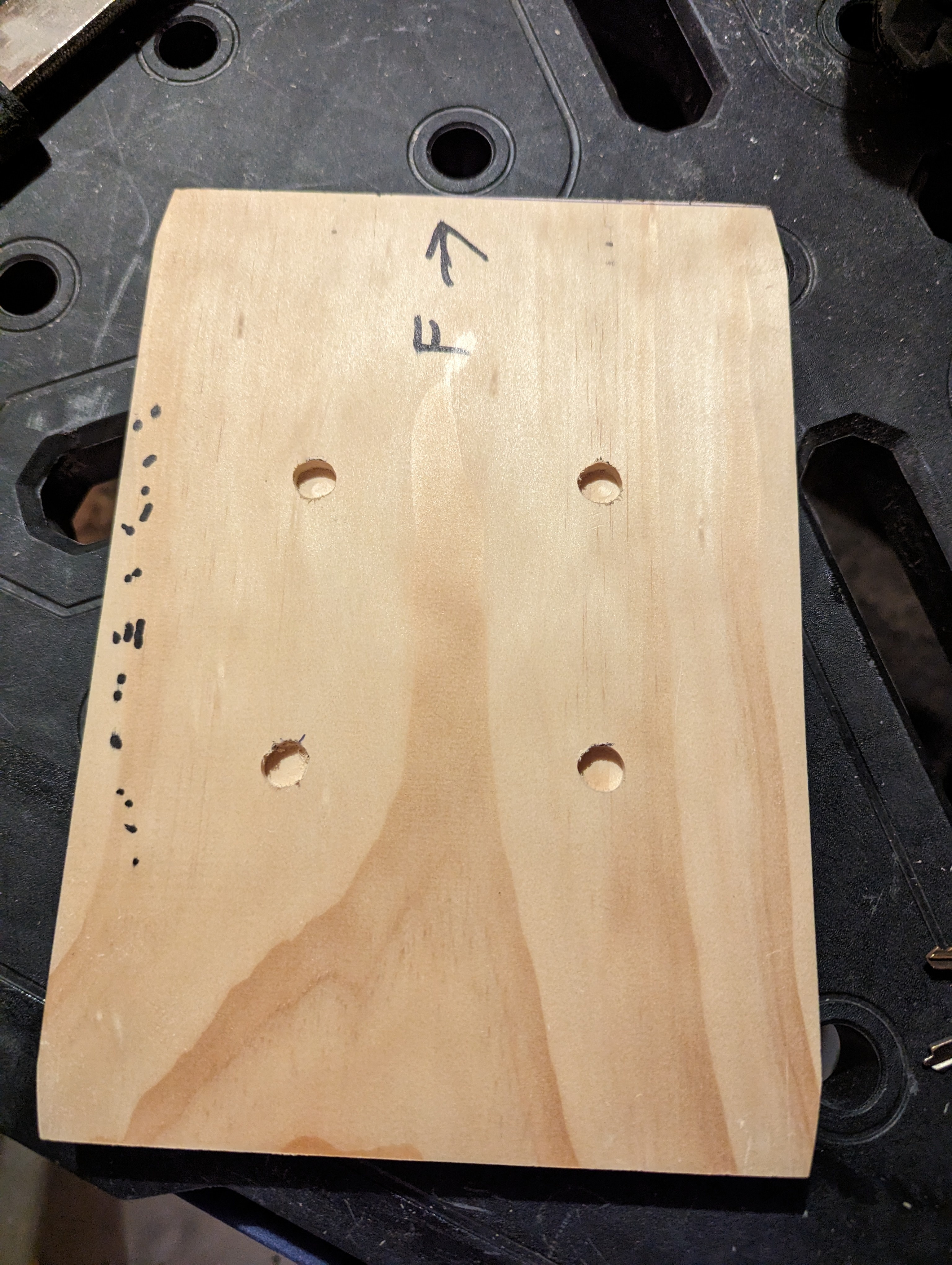 > > Measured out where the sensors should go, along with a surrounding space to screw down some little perspex windows to cover them. The idea I wanted was for the mail to be able to slide over the sensors without getting caught on them, as well as to protect them from dust. > > 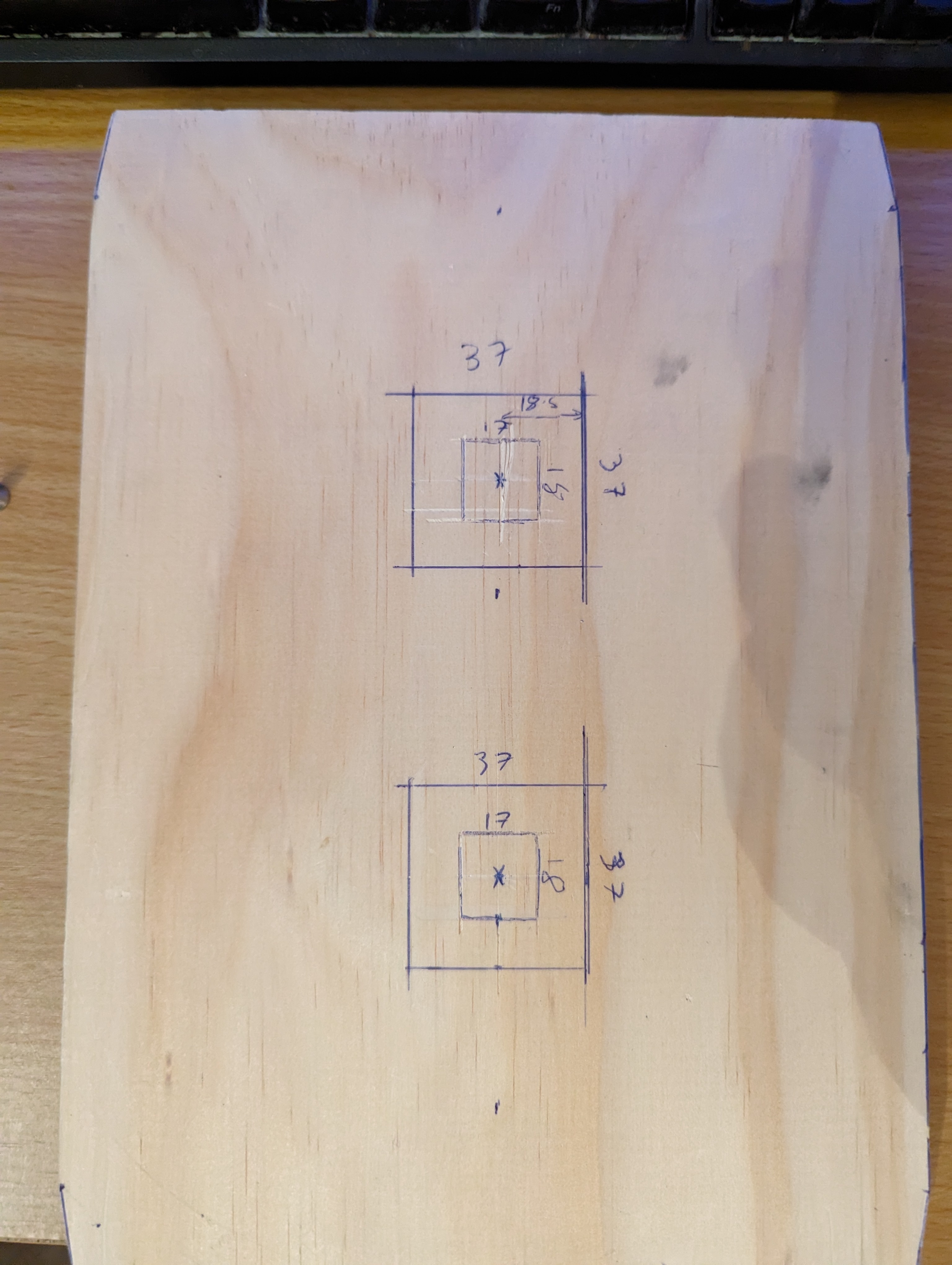 > > Routed out the dents and cleaned them up with a chisel and sandpaper. Cut the perspex to shape for a test fit. > >  > > On the other side, I routed out a notch for the cable to access the sensors. > > 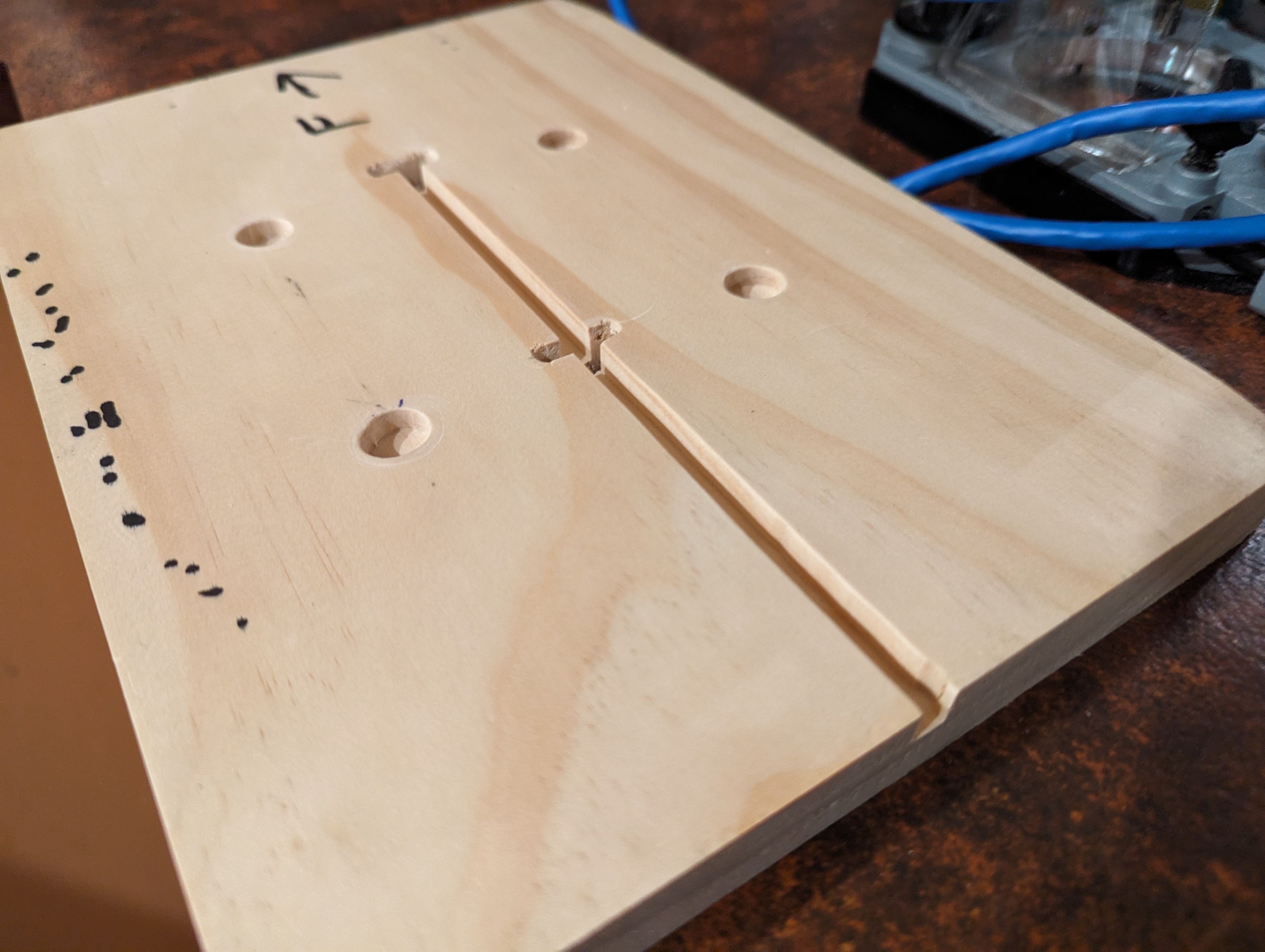 > > I had originally planned to just solder wires into the sensors, but then I realised JST connectors would fit perfectly into the sensors. This meant I had to widen the holes somewhat, which I did with a small chisel and file. > > 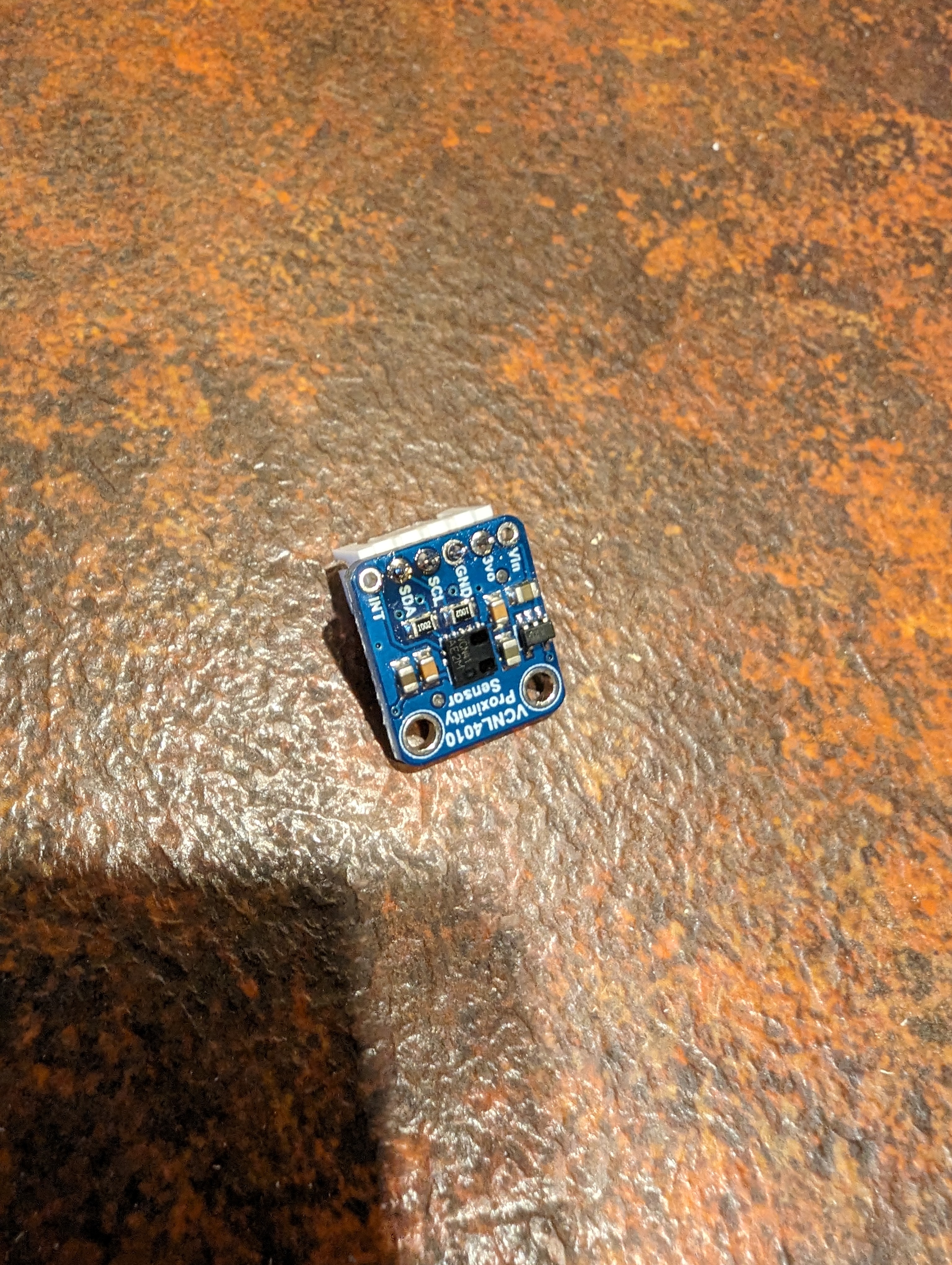 > > I got a bit lazy with making screw holes to hold down the perspex, so they're not in as neat a place as I'd like. If I did this again I'd measure properly for their placement. Still, with countersinking they hold down the perspex well and nothing sticks up for mail to get caught on. > >  > > I also got started on making a housing for the solar panels. I used the router to carve out a 1-2mm area for them to sit in, and a much deeper ditch linking the two terminals, which you'll see in a later picture. For now, here's how they look sitting in it. > >  > 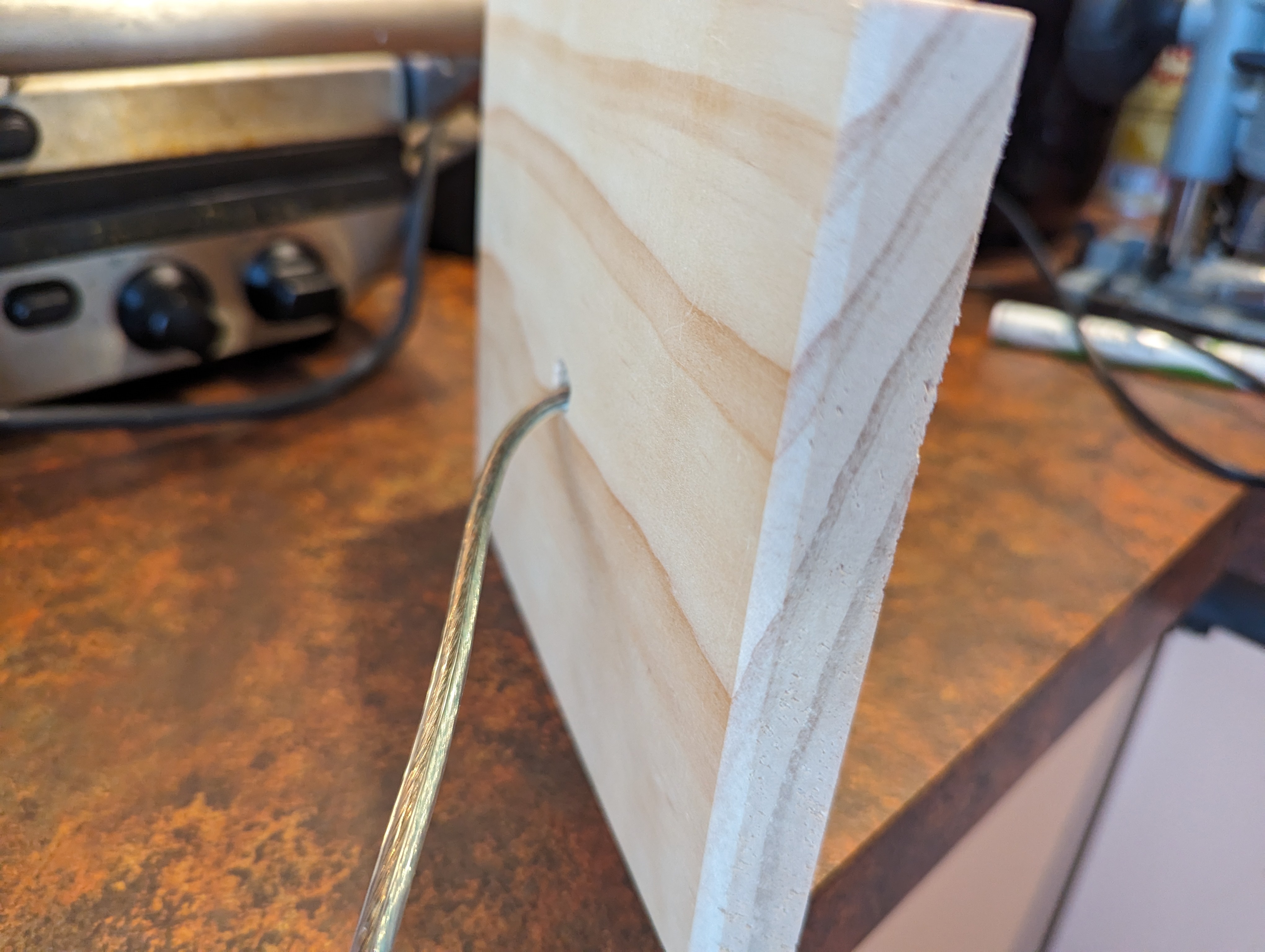 > > Wiring up the prototype board was next. Again, see the article I linked above for how this works. I used pin headers to allow the ESP32 dev board to be slotted in and out, just in case I ever needed to take it out for replacement or reprogramming. Also the JSTs on the prototype board are for connecting the battery (top left), connecting the solar panels (bottom left), providing power to the sensors (bottom right) and clock and data lines for the sensors (top right). Since the sensors are both using the same I2C bus address and cannot be configured otherwise, I had to run two clock and data lines, but if I'd found sensors that could have different addresses I could have just used one of each. I didn't take a photo of the board at this stage, but I later added another header to connect a button to reset the ESP32 from the outside. > >  > > I also made the data and power cable for the sensor board. > > 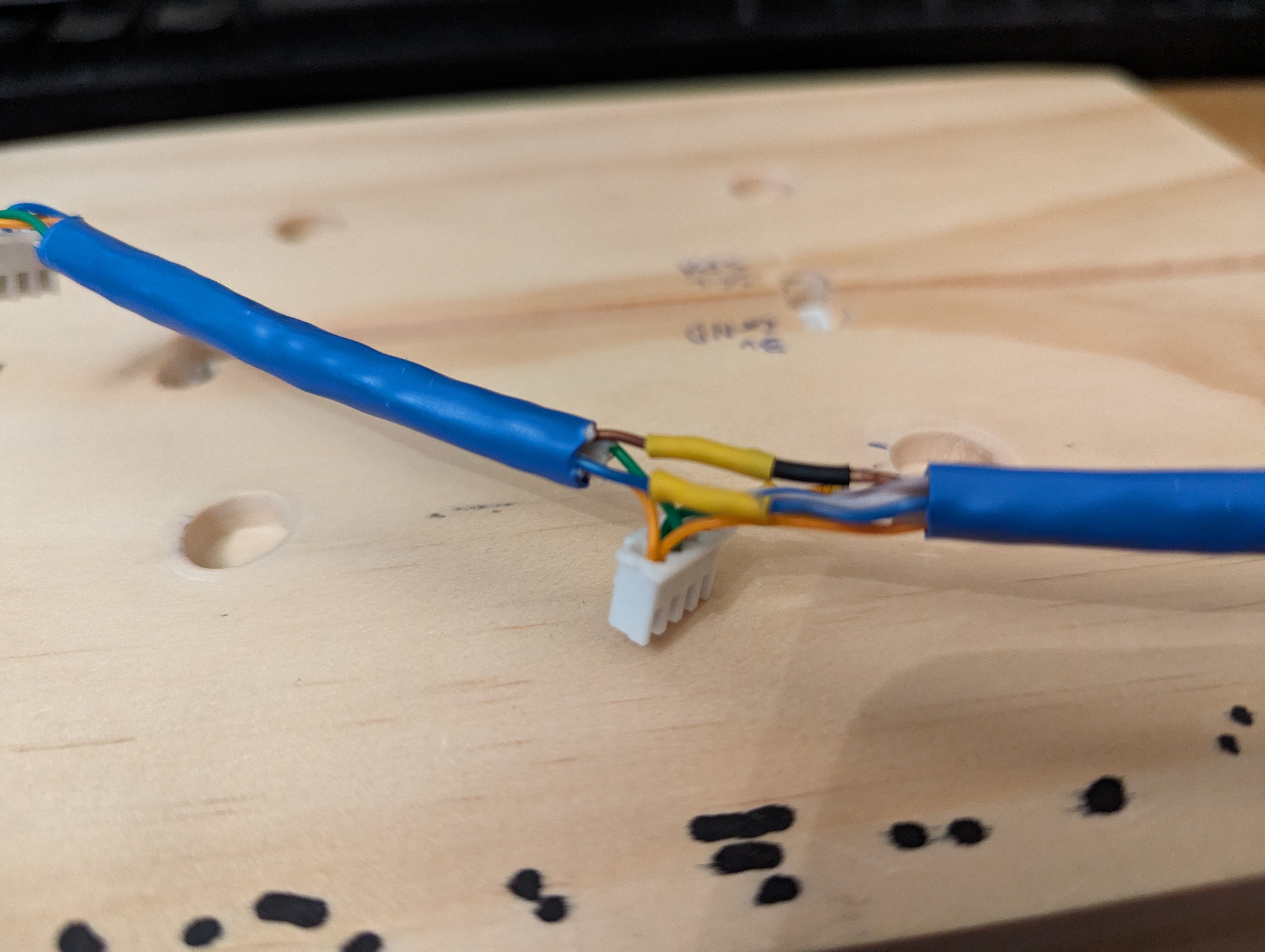 > > The solar panel housing and 'sensor plate' were both painted and treated with polyurethane spray to protect them from rain and humidity. > > 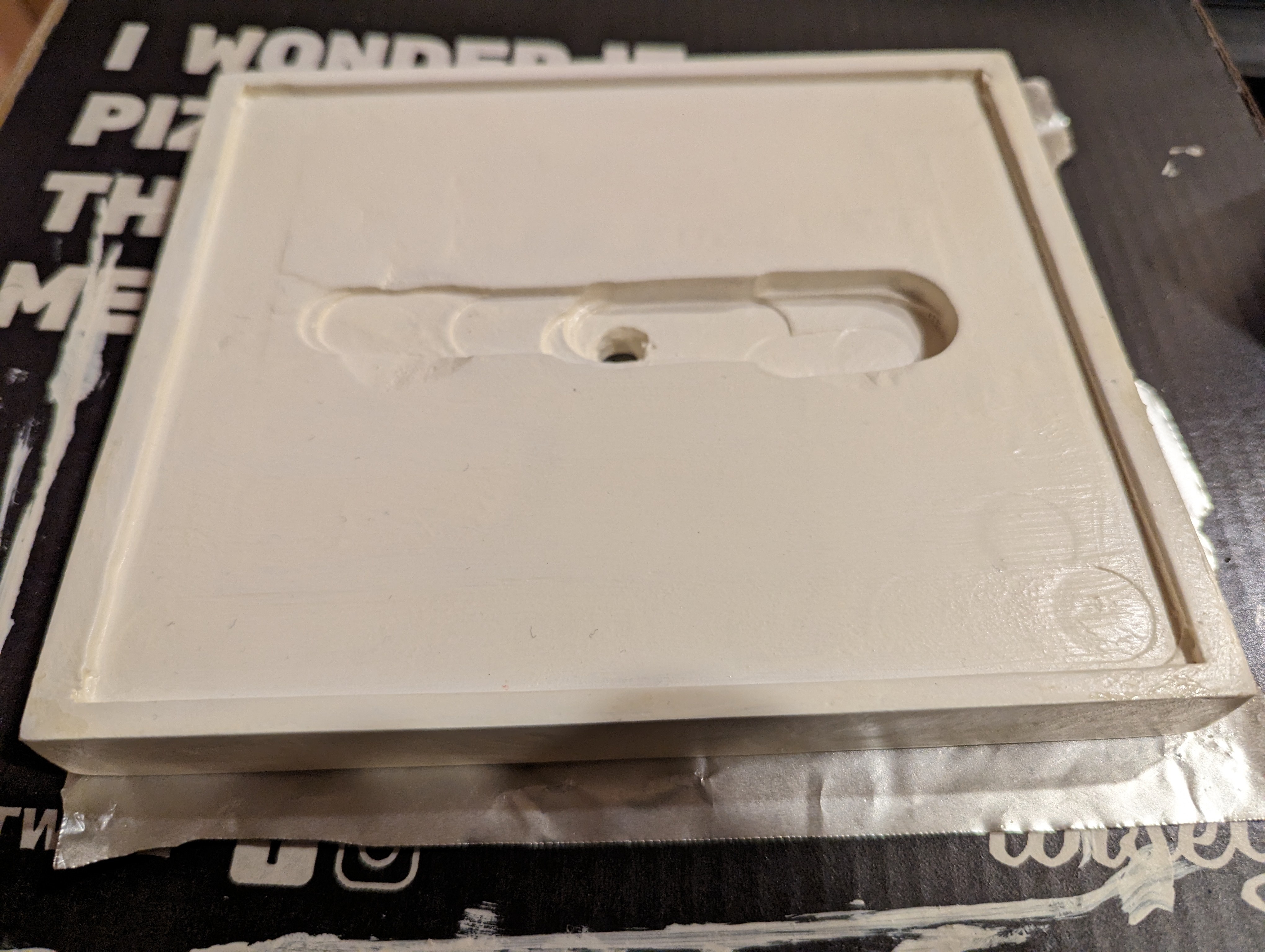 >  > > I drilled holes in the weatherproof box to fix the cable glands and the weatherproof button. In the case of the solar panel wire, I had opted to buy speaker wire since I figured it would be easier to run in the channel between the two solar panels, being flat. But that also made it not really fit the cable glands that great. I ended up stripping some of the outer sheath off some 2 wire power cable I had, and wrapping that around the part of the speaker wire that gets clamped in the glands, just to make a reasonable seal. These all were on the side I decided I would mount at the bottom, so water wouldn't be able to easily fall into the box. > >  > > Final test fit. I later used epoxy glue to glue down the nylon headers and the battery holder inside the box. > > 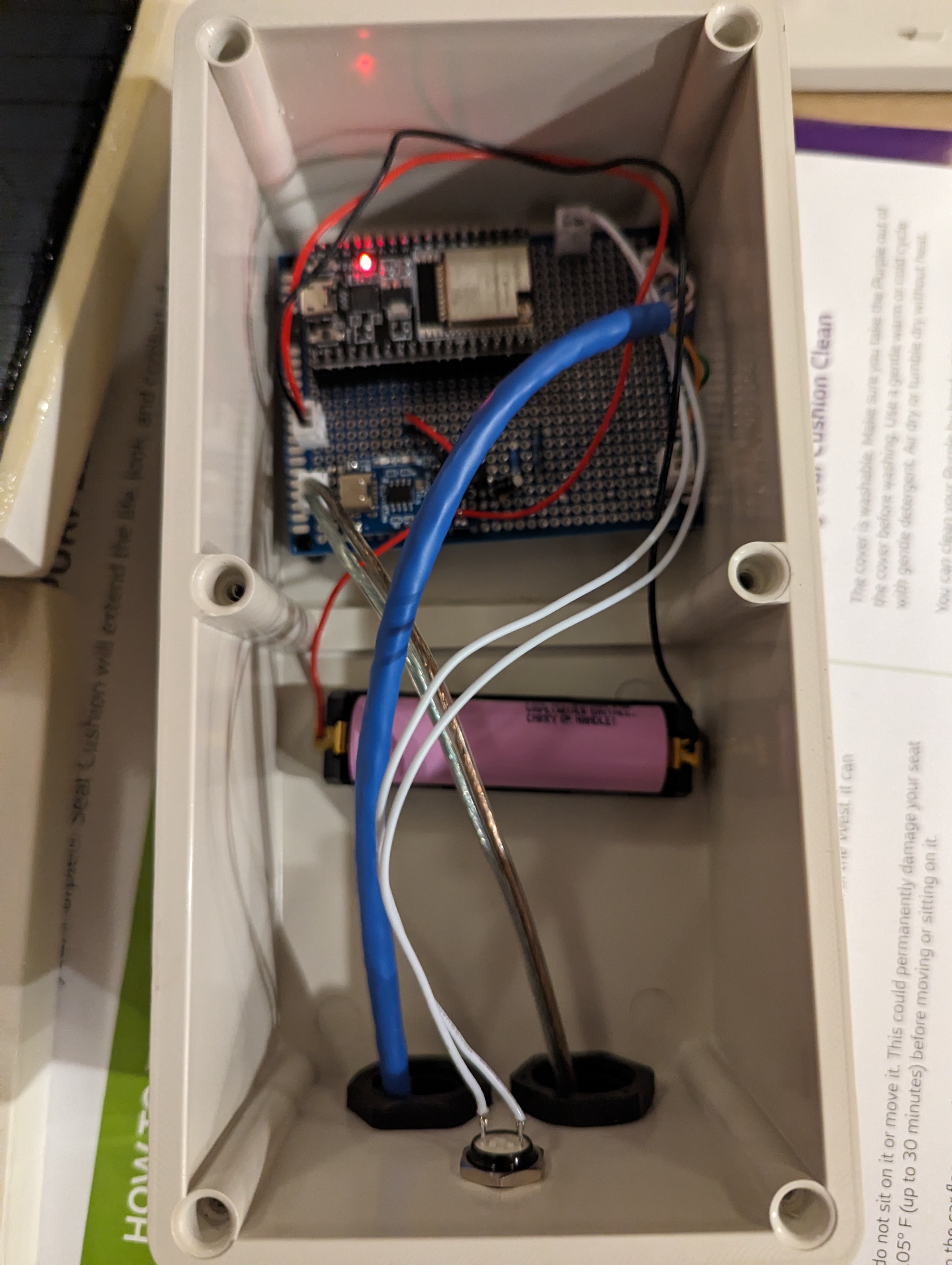 > > The mailbox itself also needed a hole in the bottom for the sensor cable to come out. After drilling a hole and filing it into a square shape, I cut some rubber grommet strip to size and fitted it around the hole, with some marine silicone adhesive to protect the sharp metal edges from water and to hold the grommet strip in place. > > 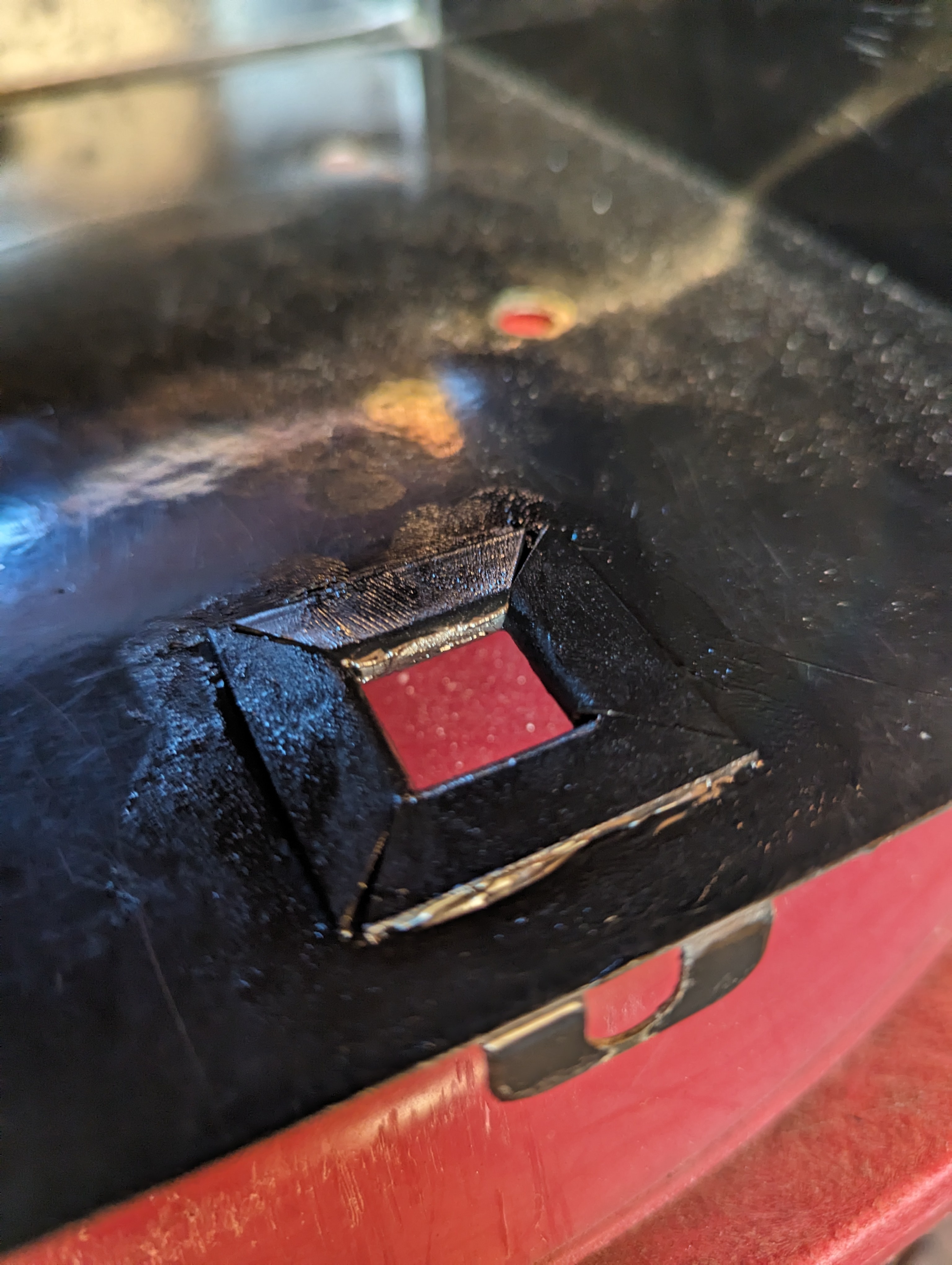 > > I'd drilled some holes in the brick wall my mailbox sits upon for masonry anchors, and this piece of treated pine got the last of my polyurethane spray, just in case. > > 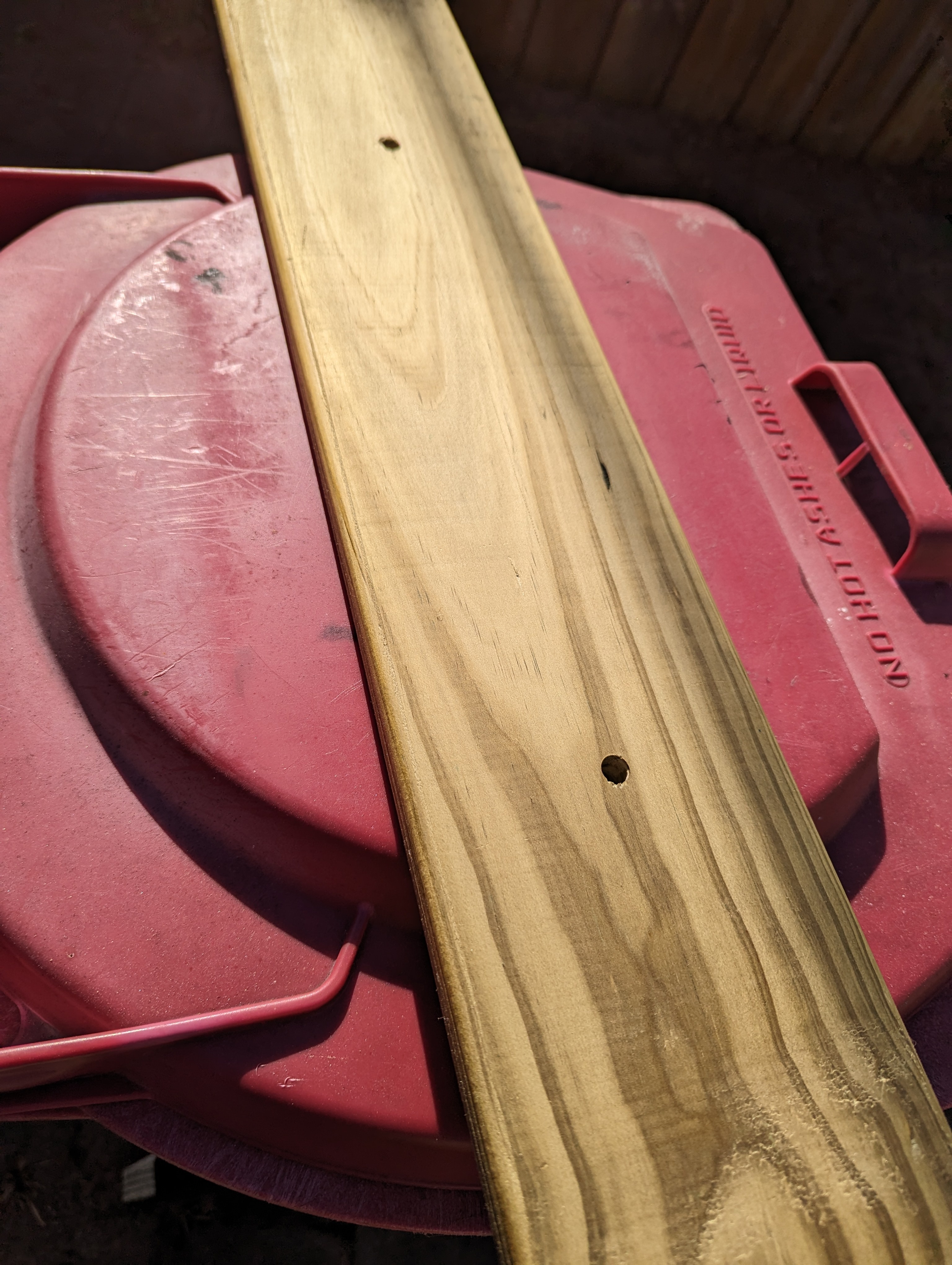 > > Using a two pieces of the leftover perspex glued together, I made an internal mount for the antenna, figuring it would be best to not have the thing either floating around freely inside the box or sticking out the side where people could potentially break it off. > >  > 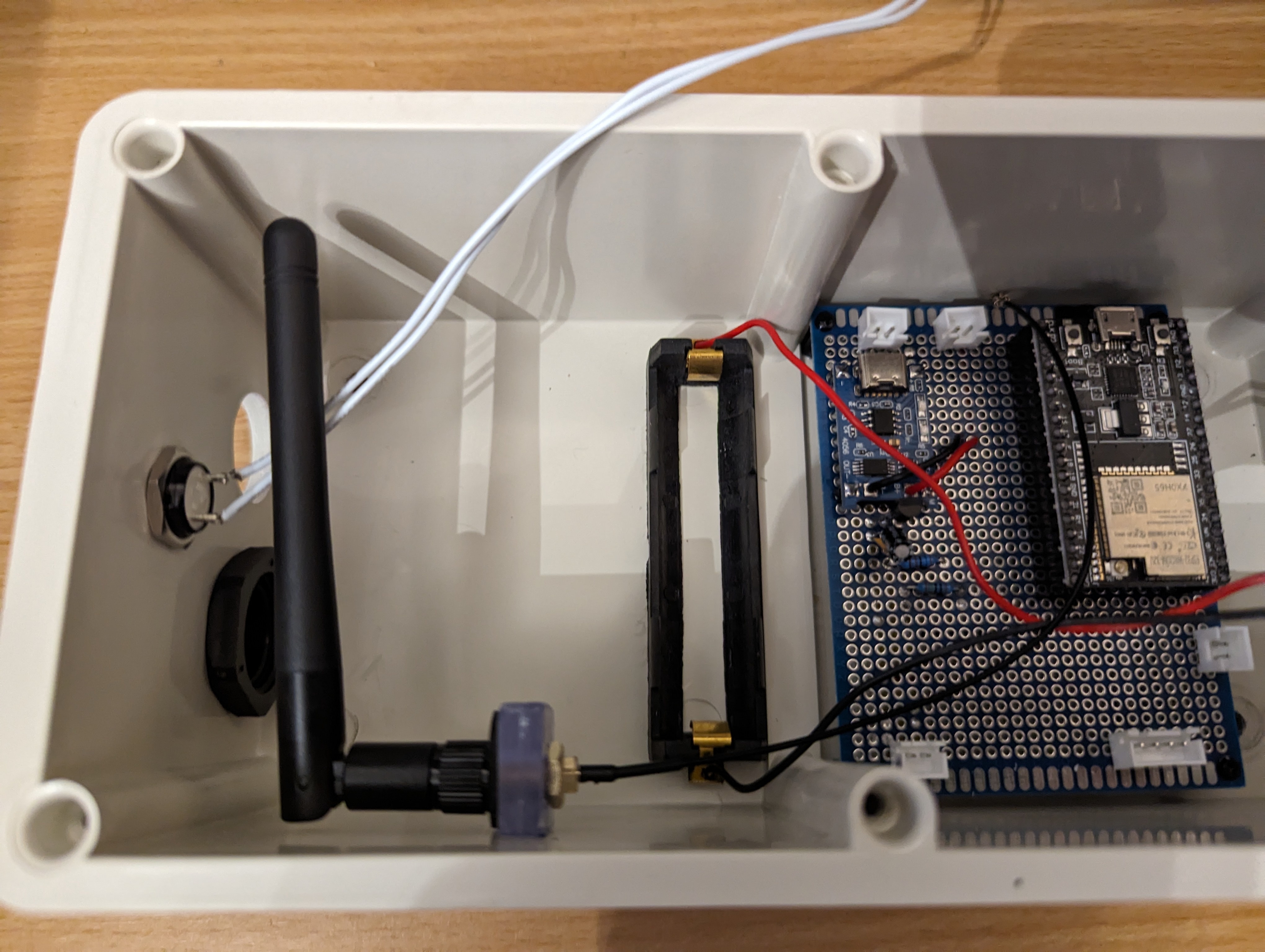 > > Finally, after weeks of off and on work, it was ready to install. > >  >  > > The ESPHome coding used [my VCNL4010 component](https://github.com/dixonte/esphome-vcnl4010), and if anyone is interested I can share it but it's kinda a large file.
It was a long running project, but I finally did it. I built what I'm calling a smart mailbox that communicates the presence of mail locally with Home Assistant via ESPHome. Parts: - Pine plank roughly the width of my mailbox - Treated pine plank for mounting - Thin sheet of perspex or similar transparent plastic - 2x [VCNL4010 proximity sensor](https://www.aliexpress.com/item/1005005450411501.html) - [ESP32 dev board with antenna](https://www.aliexpress.com/item/1005001438925793.html) - [Bigger antenna](https://www.aliexpress.com/item/1005006208040822.html) - [Prototype board](https://www.aliexpress.com/item/1005004818919331.html) - [2.54mm pitch JST connectors](https://www.aliexpress.com/item/1005003667406240.html) - [2.54mm pitch pin header sockets](https://www.aliexpress.com/item/4001198421663.html) - 18650 battery - [18650 Type-C charging module](https://www.aliexpress.com/item/32786777105.html) - Battery holder - 2x [5V 1.5W solar panels](https://www.aliexpress.com/item/33019015032.html) - [MCP1700-3302E LDO regulator](https://www.aliexpress.com/item/1005001608339185.html) - [100uF electrolytic capacitor](https://www.aliexpress.com/item/1005005691916127.html) - [100nF ceramic capacitor](https://www.aliexpress.com/item/32973259342.html) - Resistors... I think I ended up using a 1 MOhm and a 330 kOhm - [Weatherproof junction box](https://www.bunnings.com.au/deta-211mm-weatherproof-junction-box-ip56_p4330860) - [Nylon screw spacers](https://www.aliexpress.com/item/32862529967.html) - [Cable glands](https://www.aliexpress.com/item/1005006211622214.html) - [12mm waterproof button](https://www.aliexpress.com/item/4001362443186.html) - Various cables and wires - Paint and polyurethane spray to weatherproof the wood Tools: - Soldering iron - Router for cutting grooves in wood - Drill and hole saw bits - Various files and sandpaper For a start, I followed [this guide](https://randomnerdtutorials.com/power-esp32-esp8266-solar-panels-battery-level-monitoring/) to get me started on the power delivery portion, but I ended up using much higher valued resistors since I found that I was losing more battery charge through the voltage divider than I was from the ESP32 or proximity sensors. Once I'd tested the concept with the parts just laying in a jumble on the table, it was time to get to work. I started by cutting a plank of pine to fit my mailbox, chamfering the ends to make space for the metal joins. I routed out some spaces for the tops of the bolts that hold the mailbox down.  Measured out where the sensors should go, along with a surrounding space to screw down some little perspex windows to cover them. The idea I wanted was for the mail to be able to slide over the sensors without getting caught on them, as well as to protect them from dust.  Routed out the dents and cleaned them up with a chisel and sandpaper. Cut the perspex to shape for a test fit.  On the other side, I routed out a notch for the cable to access the sensors.  I had originally planned to just solder wires into the sensors, but then I realised JST connectors would fit perfectly into the sensors. This meant I had to widen the holes somewhat, which I did with a small chisel and file. 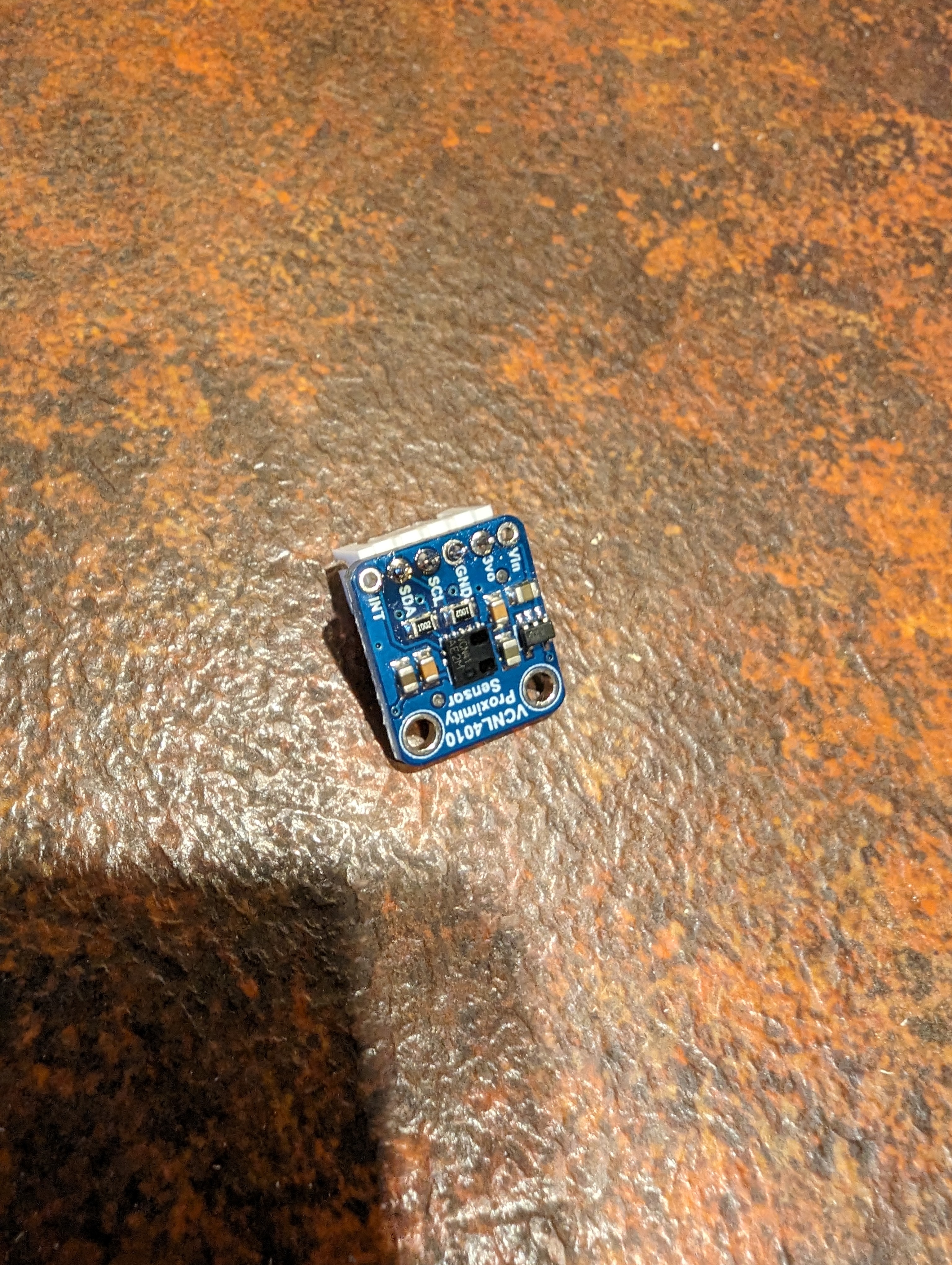 I got a bit lazy with making screw holes to hold down the perspex, so they're not in as neat a place as I'd like. If I did this again I'd measure properly for their placement. Still, with countersinking they hold down the perspex well and nothing sticks up for mail to get caught on. 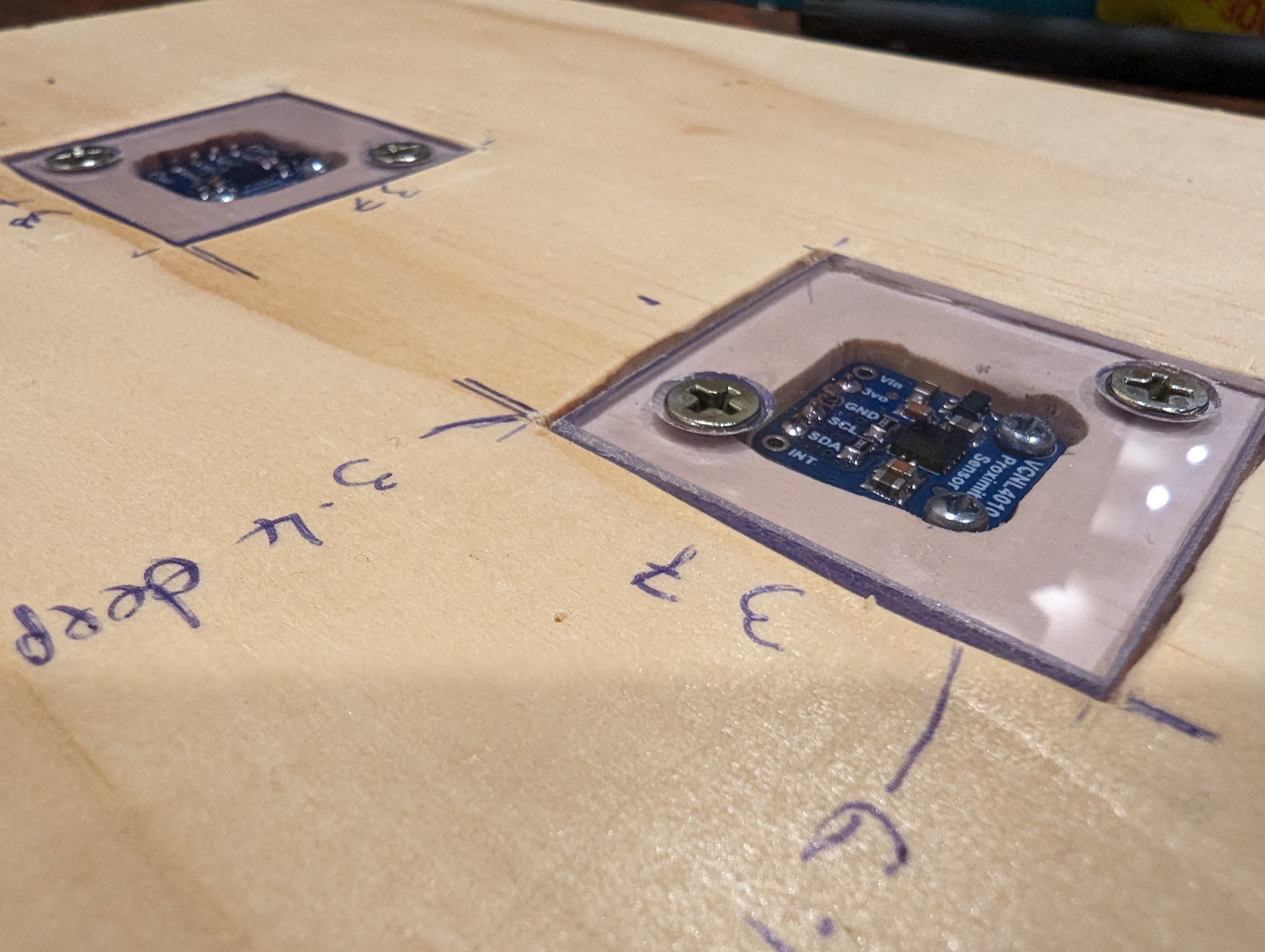 I also got started on making a housing for the solar panels. I used the router to carve out a 1-2mm area for them to sit in, and a much deeper ditch linking the two terminals, which you'll see in a later picture. For now, here's how they look sitting in it. 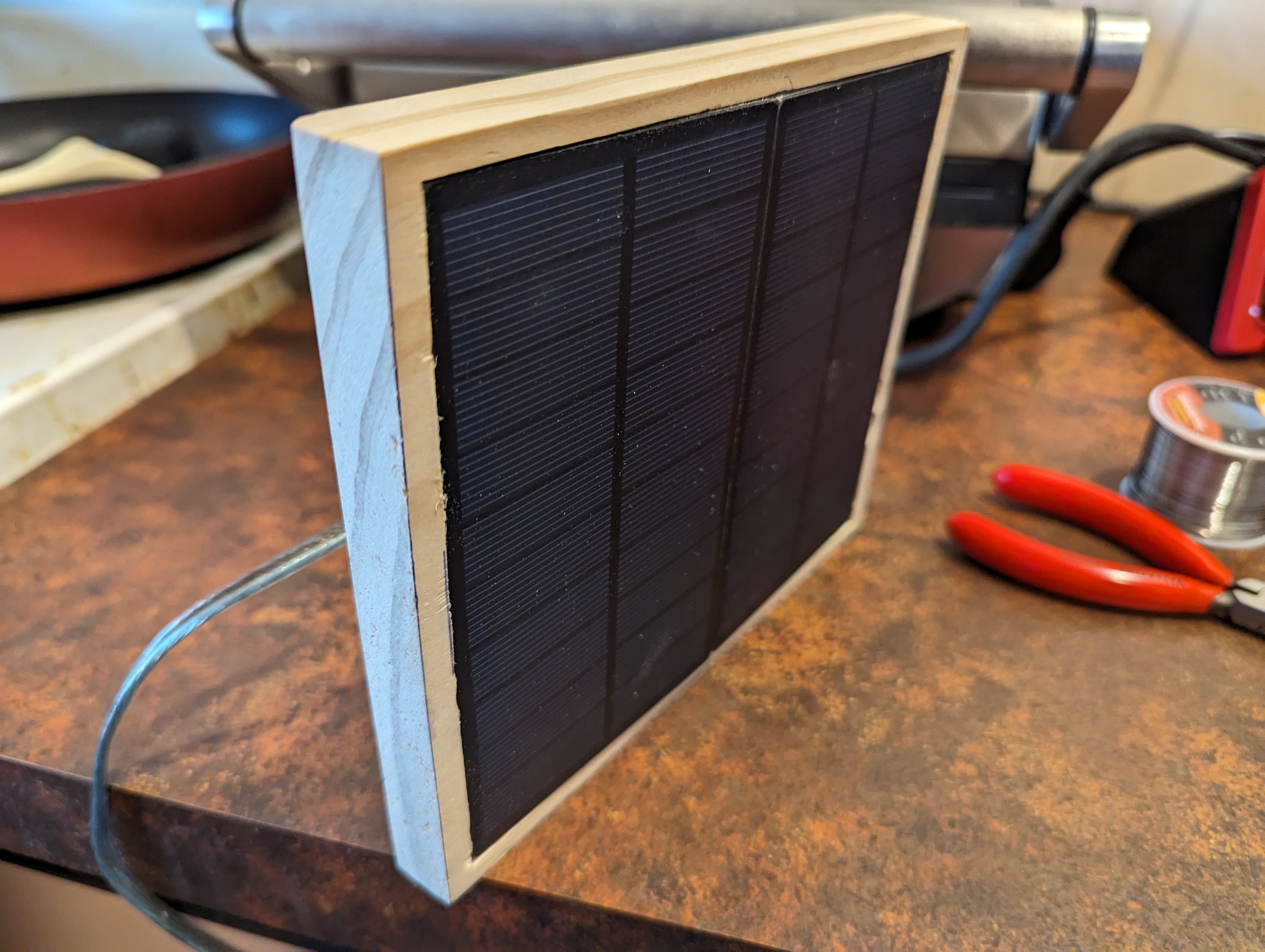 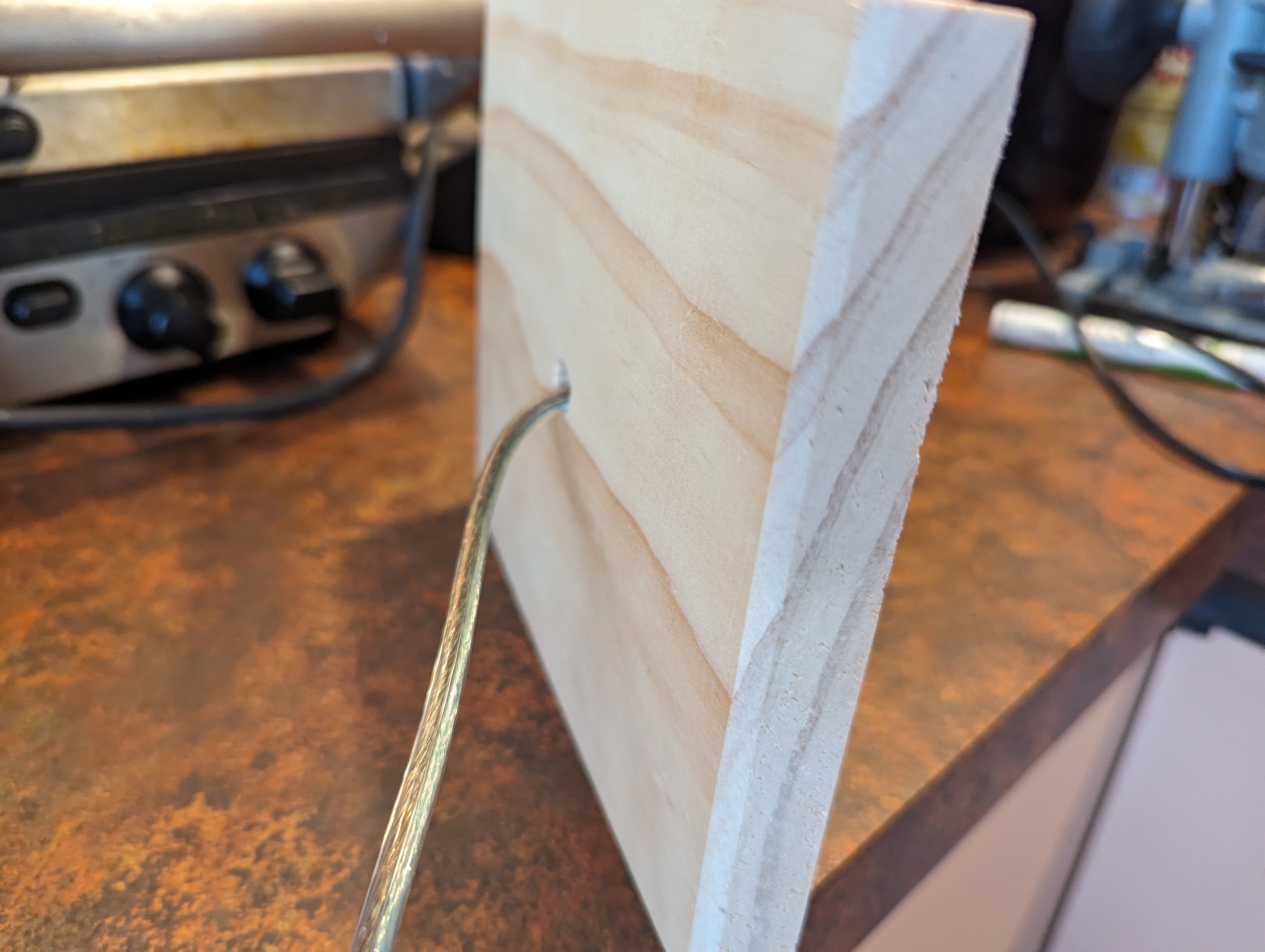 Wiring up the prototype board was next. Again, see the article I linked above for how this works. I used pin headers to allow the ESP32 dev board to be slotted in and out, just in case I ever needed to take it out for replacement or reprogramming. Also the JSTs on the prototype board are for connecting the battery (top left), connecting the solar panels (bottom left), providing power to the sensors (bottom right) and clock and data lines for the sensors (top right). Since the sensors are both using the same I2C bus address and cannot be configured otherwise, I had to run two clock and data lines, but if I'd found sensors that could have different addresses I could have just used one of each. I didn't take a photo of the board at this stage, but I later added another header to connect a button to reset the ESP32 from the outside. 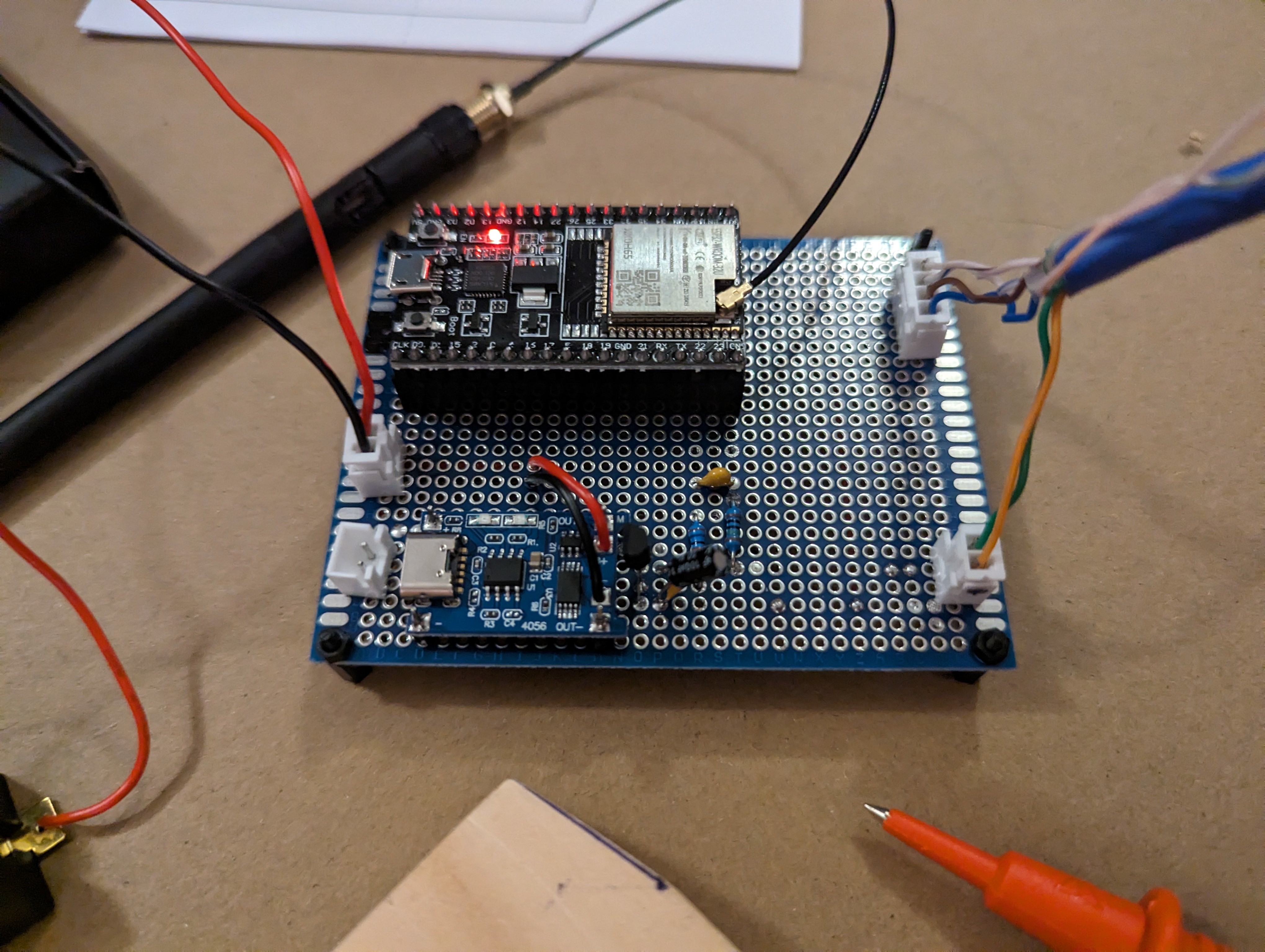 I also made the data and power cable for the sensor board.  The solar panel housing and 'sensor plate' were both painted and treated with polyurethane spray to protect them from rain and humidity.  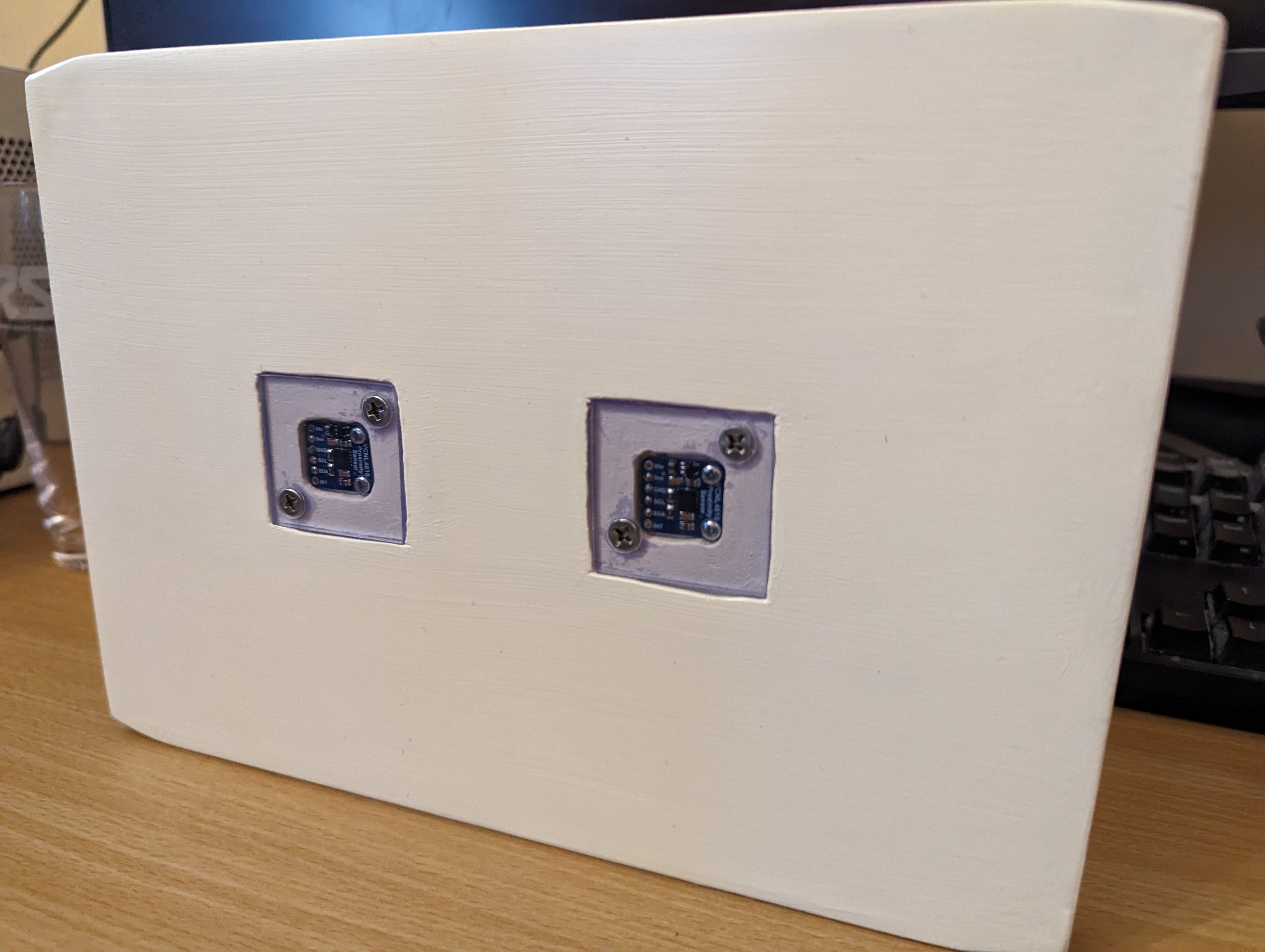 And the panels themselves were sealed in with a tonne of silicone. It made a real mess, but I'm confident no water is going to get in there. 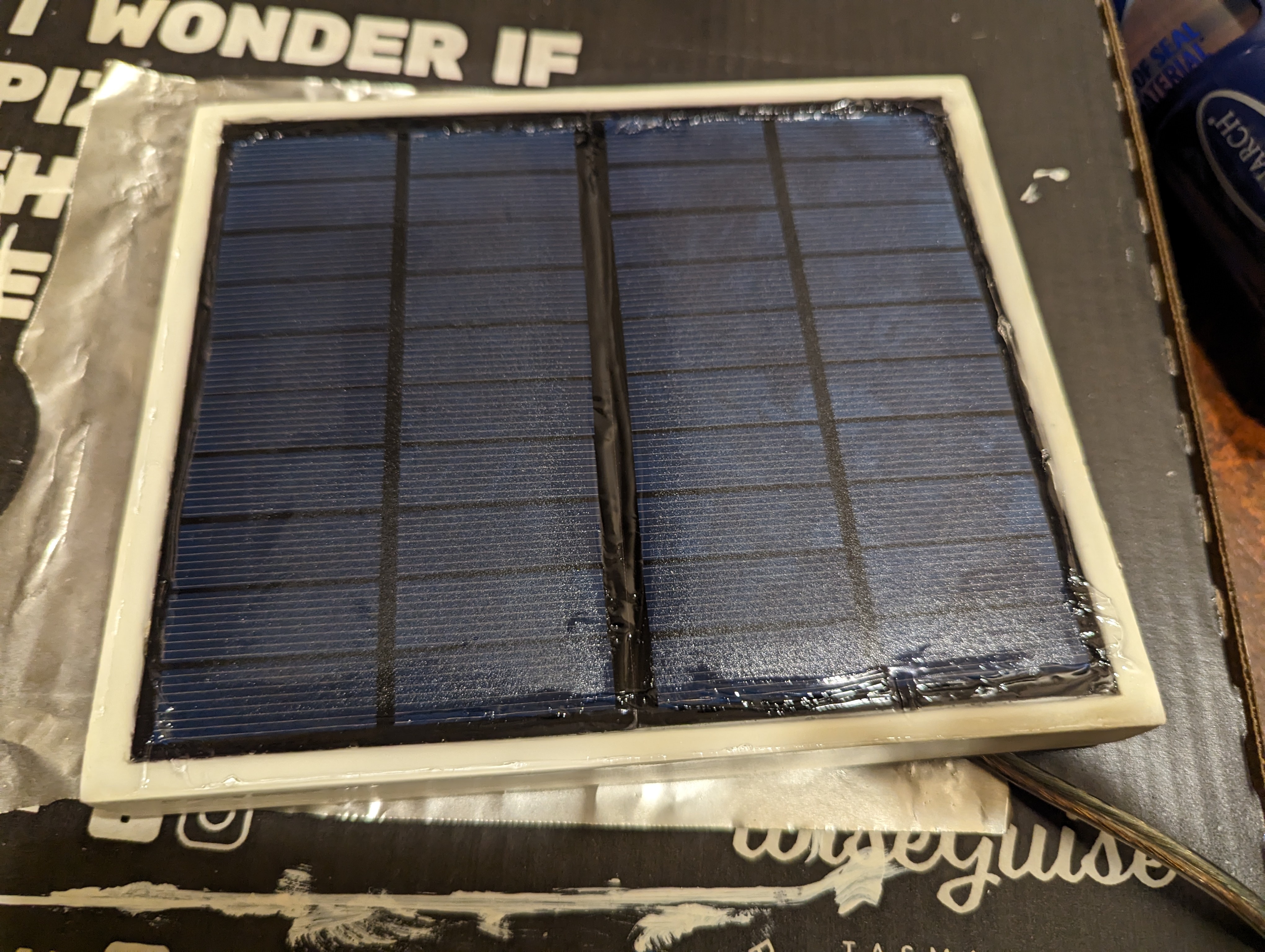  I drilled holes in the weatherproof box to fix the cable glands and the weatherproof button. In the case of the solar panel wire, I had opted to buy speaker wire since I figured it would be easier to run in the channel between the two solar panels, being flat. But that also made it not really fit the cable glands that great. I ended up stripping some of the outer sheath off some 2 wire power cable I had, and wrapping that around the part of the speaker wire that gets clamped in the glands, just to make a reasonable seal. These all were on the side I decided I would mount at the bottom, so water wouldn't be able to easily fall into the box. 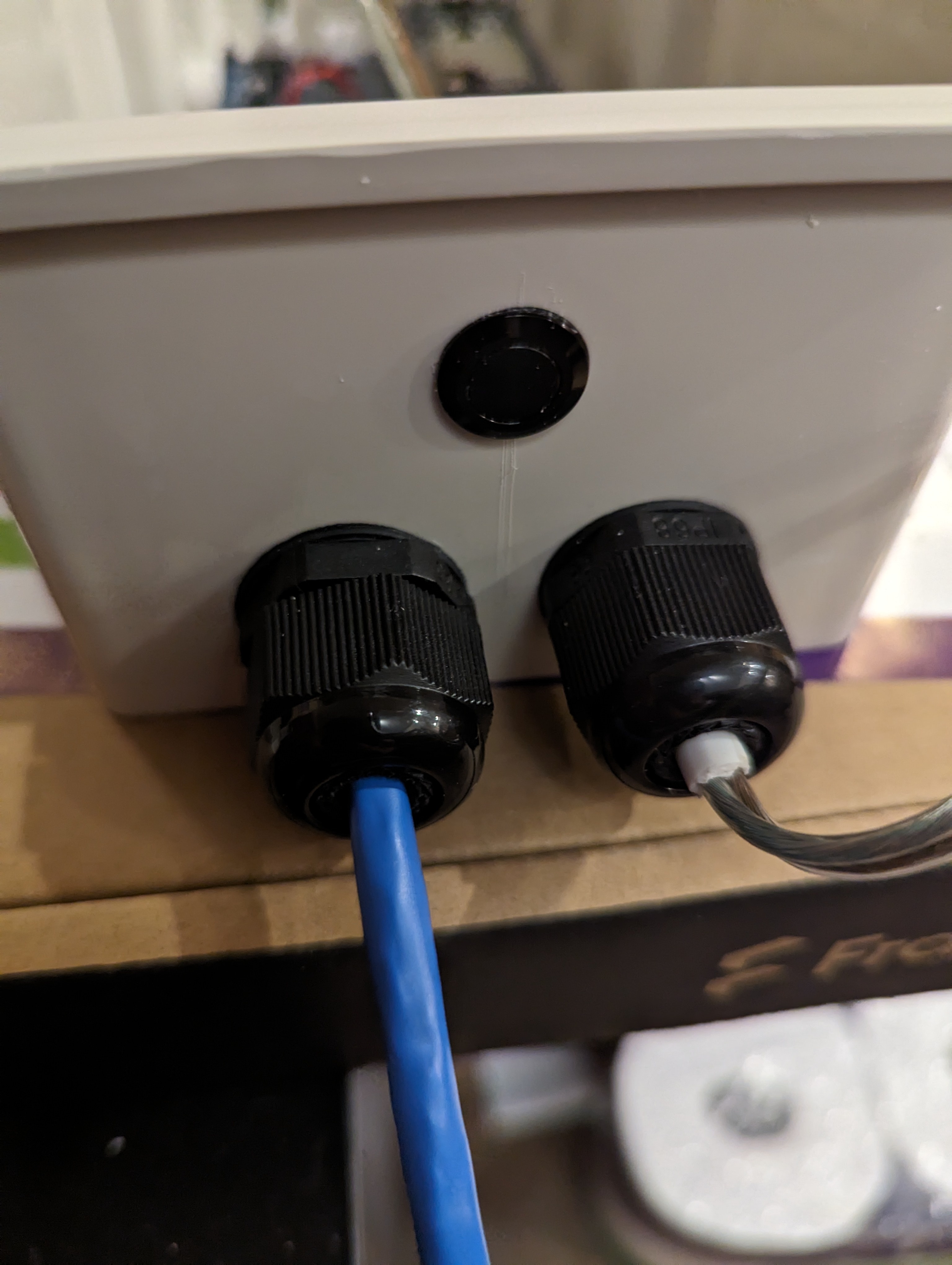 Final test fit. I later used epoxy glue to glue down the nylon headers and the battery holder inside the box. This means the prototype board can also be easily removed, as can the ESP32 dev board and the battery, but the battery holder cannot. Let's hope I never have to get that thing out.  The mailbox itself also needed a hole in the bottom for the sensor cable to come out. After drilling a hole and filing it into a square shape, I cut some rubber grommet strip to size and fitted it around the hole, with some marine silicone adhesive to protect the sharp metal edges from water and to hold the grommet strip in place.  I'd drilled some holes in the brick wall my mailbox sits upon for masonry anchors, and this piece of treated pine got the last of my polyurethane spray, just in case.  Using a two pieces of the leftover perspex glued together, I made an internal mount for the antenna, figuring it would be best to not have the thing either floating around freely inside the box or sticking out the side where people could potentially break it off.   Finally, after weeks of off and on work, it was ready to install.   The ESPHome coding used [my VCNL4010 component](https://github.com/dixonte/esphome-vcnl4010), and if anyone is interested I can share it but it's kinda a large file. I had originally planned to just use Arduino IDE and talk directly to MQTT, in order to keep things simple and just use the Adafruit VCNL4010 library, but in the end elected to use ESPHome. For, among other things, its support for over the air updates.
cross-posted from: https://lemmy.world/post/12979137 > I made an ESPHome external component for the VCNL4010 proximity sensor. > > Hopefully it's of use to someone.
 github.com
github.com
I made an ESPHome external component for the VCNL4010 proximity sensor. Hopefully it's of use to someone.
